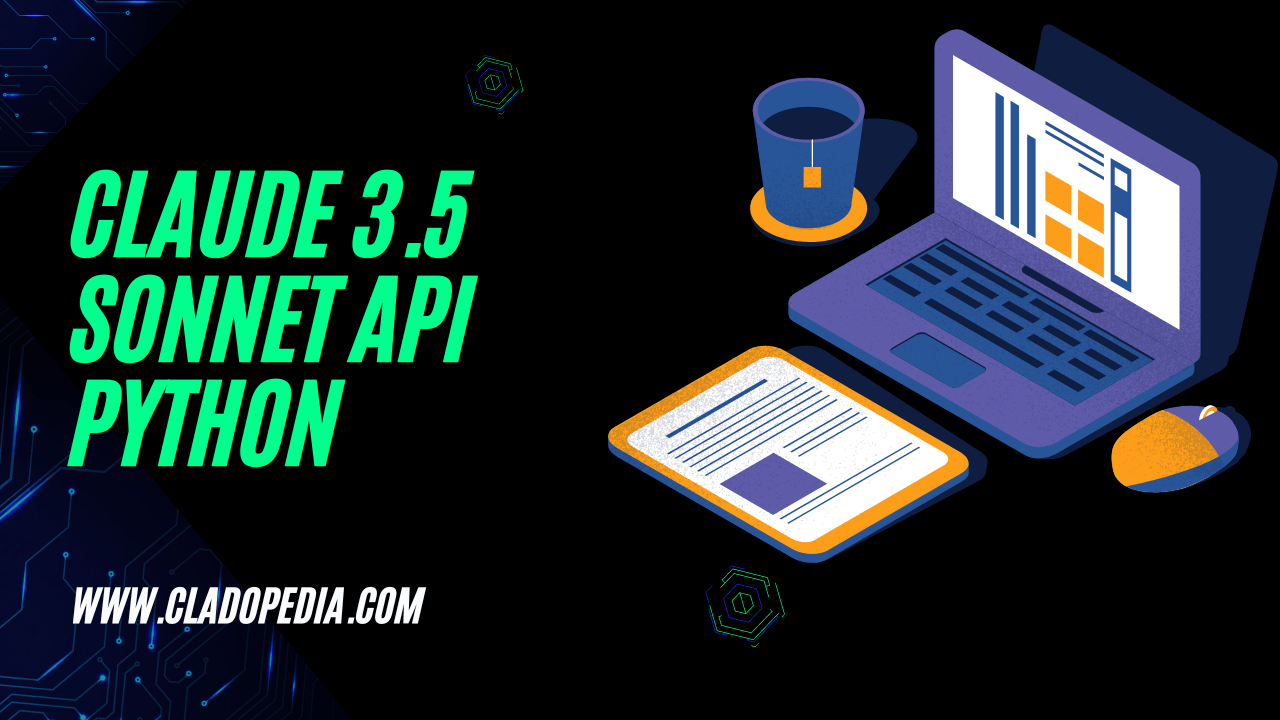Claude 3.5 Sonnet Api Python . The rise of artificial intelligence (AI) has led to the development of advanced models capable of performing complex tasks with high accuracy. One such model is Claude 3.5 Sonnet, a powerful AI designed for natural language processing (NLP). Accessing the capabilities of Claude 3.5 Sonnet through its API (Application Programming Interface) opens a world of possibilities for developers looking to integrate advanced AI functionalities into their applications.
This article explores the Claude 3.5 Sonnet API in Python, covering its features, installation, usage, and practical examples.
Understanding the Claude 3.5 Sonnet API
The Claude 3.5 Sonnet API provides developers with a streamlined way to interact with the model, enabling them to leverage its advanced language processing capabilities for various applications. Whether you want to generate text, analyze sentiment, or create conversational agents, the API offers the necessary tools to do so effectively.
Key Features of the Claude 3.5 Sonnet API
- Natural Language Generation: Generate human-like text based on prompts, making it suitable for chatbots, content creation, and more.
- Text Analysis: Analyze and summarize text, extract key information, and perform sentiment analysis.
- Conversational AI: Build interactive applications that can engage users in meaningful dialogues.
- Customizability: Tailor responses and behavior to fit specific use cases and requirements.
Getting Started with the Claude 3.5 Sonnet API
Prerequisites
Before diving into using the Claude 3.5 Sonnet API, ensure you have the following:
- Python: The API is accessible using Python, so make sure you have Python 3.x installed on your system.
- API Key: You will need an API key from the service provider to authenticate your requests.
- IDE or Text Editor: Use any Integrated Development Environment (IDE) or text editor of your choice for coding.
Installation
To interact with the Claude 3.5 Sonnet API in Python, you may need to install certain libraries. The primary library used for making HTTP requests is requests. To install it, run the following command:
pip install requestsSetting Up the API Connection
Authentication
To connect to the Claude 3.5 Sonnet API, you need to authenticate using your API key. Here’s how to set up the connection:
- Obtain Your API Key: Sign up for the Claude API service and obtain your API key.
- Store the Key: For security purposes, store your API key in an environment variable or a configuration file.
Example Code for API Authentication
Here’s an example of how to authenticate your API requests using Python:
import os
import requests
# Load your API key from an environment variable
API_KEY = os.getenv("CLAUDE_API_KEY")
# Define the base URL for the API
BASE_URL = "https://api.claude.ai/v1"
# Set up headers for authentication
headers = {
"Authorization": f"Bearer {API_KEY}",
"Content-Type": "application/json"
}Making API Requests
Once the connection is established, you can start making requests to the Claude 3.5 Sonnet API. The API supports various endpoints for different functionalities.
1. Text Generation
One of the most popular features of the Claude API is text generation. You can generate human-like text by sending a prompt to the API.
Example Code for Text Generation
def generate_text(prompt):
endpoint = f"{BASE_URL}/generate"
data = {
"prompt": prompt,
"max_tokens": 100, # Limit the number of tokens in the generated output
"temperature": 0.7 # Adjusts the randomness of the output
}
response = requests.post(endpoint, headers=headers, json=data)
if response.status_code == 200:
generated_text = response.json().get("text")
return generated_text
else:
print("Error:", response.status_code, response.text)
return None
# Example usage
prompt = "What are the benefits of using AI in healthcare?"
generated_output = generate_text(prompt)
print(generated_output)2. Text Analysis
The Claude 3.5 Sonnet API also supports text analysis functionalities, allowing you to analyze text for sentiment, summarization, and more.
Example Code for Sentiment Analysis
def analyze_sentiment(text):
endpoint = f"{BASE_URL}/analyze/sentiment"
data = {
"text": text
}
response = requests.post(endpoint, headers=headers, json=data)
if response.status_code == 200:
sentiment = response.json().get("sentiment")
return sentiment
else:
print("Error:", response.status_code, response.text)
return None
# Example usage
text_to_analyze = "I am thrilled with the results of my project!"
sentiment_result = analyze_sentiment(text_to_analyze)
print("Sentiment:", sentiment_result)3. Conversational API
For building chatbots or conversational agents, you can utilize the conversational capabilities of the Claude API.
Example Code for Conversational Interaction
def converse_with_claude(user_input, conversation_history):
endpoint = f"{BASE_URL}/chat"
data = {
"input": user_input,
"history": conversation_history
}
response = requests.post(endpoint, headers=headers, json=data)
if response.status_code == 200:
bot_response = response.json().get("response")
return bot_response
else:
print("Error:", response.status_code, response.text)
return None
# Example usage
conversation_history = []
user_message = "Hello, how can you help me today?"
bot_reply = converse_with_claude(user_message, conversation_history)
print("Bot:", bot_reply)
# Append user input and bot response to the history
conversation_history.append({"user": user_message, "bot": bot_reply})Best Practices for Using the Claude 3.5 Sonnet API
When working with the Claude 3.5 Sonnet API, consider the following best practices:
1. Rate Limiting
Respect the API’s rate limits to avoid being throttled or blocked. Check the API documentation for details on the allowed number of requests per minute.
2. Error Handling
Implement robust error handling in your code to manage API responses effectively. This includes handling different status codes and retrying failed requests if necessary.
3. Token Management
Monitor the number of tokens used in your requests, especially when generating long outputs. Adjust the max_tokens parameter as needed.
4. Security Practices
Keep your API key secure. Avoid hardcoding it in your scripts. Instead, use environment variables or configuration files.
Real-World Applications of Claude 3.5 Sonnet API
The Claude 3.5 Sonnet API can be utilized in various industries and applications, enhancing productivity and user engagement.
1. Content Creation
Bloggers and marketers can use the API to generate high-quality articles, social media posts, and marketing copy, saving time and enhancing creativity.
2. Customer Support
Businesses can integrate the API into their customer support systems, creating chatbots that provide instant assistance and answer frequently asked questions.
3. Education
Educational platforms can leverage the API to create interactive learning experiences, providing students with explanations, summaries, and feedback on their work.
4. Mental Health Support
The API can be used in mental health applications to offer supportive conversations and resources, providing users with a safe space to express their feelings.
Challenges and Limitations
While the Claude 3.5 Sonnet API offers remarkable capabilities, there are challenges and limitations to consider:
1. Context Limitations
The model may sometimes struggle to maintain context over long conversations or complex interactions. Developers should design their applications to handle such cases effectively.
2. Dependence on Quality of Input
The output quality is highly dependent on the quality of input prompts. Clear and specific prompts yield better results.
3. Ethical Considerations
As with any AI technology, ethical considerations should be taken into account. Developers must ensure that their applications do not promote harmful content or misinformation.
Future Developments
The Claude 3.5 Sonnet API is expected to evolve, with ongoing improvements in natural language understanding and generation. Future developments may include:
1. Enhanced Multimodal Capabilities
Incorporating multimodal functionalities that allow the model to process images, audio, and video alongside text could enhance user interactions significantly.
2. Improved Personalization
Future iterations of the API may offer more advanced personalization features, allowing applications to adapt responses based on user behavior and preferences.
3. Greater Customizability
Developers may gain more control over the model’s behavior and responses, enabling them to fine-tune applications to meet specific needs.
Conclusion
The Claude 3.5 Sonnet API provides developers with a powerful tool for integrating advanced natural language processing capabilities into their applications. From text generation to sentiment analysis and conversational AI, the API offers a wide range of functionalities that can enhance user experiences across various domains. By following best practices and considering the challenges, developers can leverage this API to build innovative and impactful applications.

FAQs
1. How do I obtain an API key for Claude 3.5 Sonnet?
To obtain an API key, sign up for the Claude API service on their official website. After registration, you will receive your unique API key.
2. Can I use the Claude API for free?
The Claude API may offer free-tier usage with limitations on the number of requests. Check their pricing page for details on plans and costs.
3. What programming languages are supported for the Claude API?
While this article focuses on Python, the Claude API can be accessed using any programming language that supports HTTP requests, including JavaScript, Ruby, and Java.
4. Are there any rate limits for API requests?
Yes, the Claude API imposes rate limits on the number of requests you can make within a certain timeframe. Refer to the API documentation for specific limits.
5. How can I provide feedback on the API?
Most API services have a feedback mechanism in their documentation or support channels. Reach out to them with your suggestions or issues.
